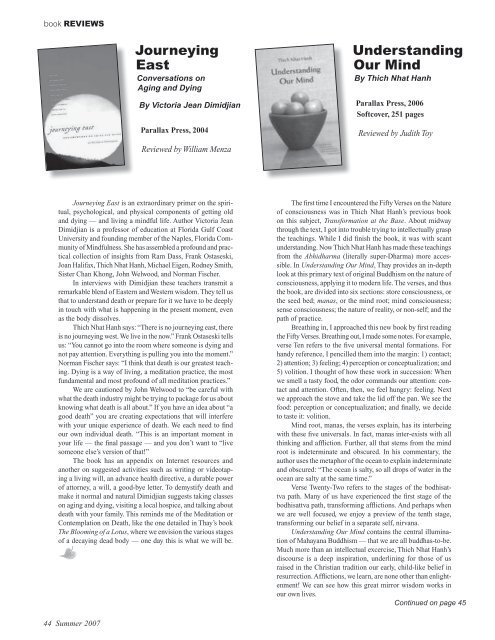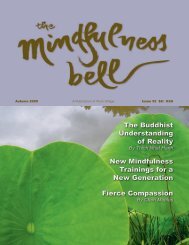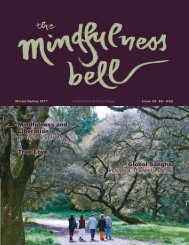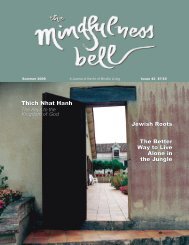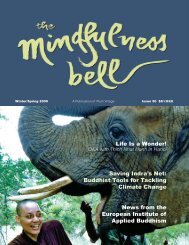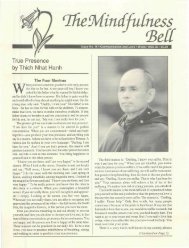Thich Nhat Hanh Healing in Vietnam The Wonderful World of Gathas
Thich Nhat Hanh Healing in Vietnam The Wonderful World of Gathas
Thich Nhat Hanh Healing in Vietnam The Wonderful World of Gathas
- No tags were found...
Create successful ePaper yourself
Turn your PDF publications into a flip-book with our unique Google optimized e-Paper software.
ook REVIEWSJourney<strong>in</strong>gEastConversations onAg<strong>in</strong>g and Dy<strong>in</strong>gBy Victoria Jean DimidjianParallax Press, 2004Reviewed by William MenzaUnderstand<strong>in</strong>gOur M<strong>in</strong>dBy <strong>Thich</strong> <strong>Nhat</strong> <strong>Hanh</strong>Parallax Press, 2006S<strong>of</strong>tcover, 251 pagesReviewed by Judith ToyJourney<strong>in</strong>g East is an extraord<strong>in</strong>ary primer on the spiritual,psychological, and physical components <strong>of</strong> gett<strong>in</strong>g oldand dy<strong>in</strong>g — and liv<strong>in</strong>g a m<strong>in</strong>dful life. Author Victoria JeanDimidjian is a pr<strong>of</strong>essor <strong>of</strong> education at Florida Gulf CoastUniversity and found<strong>in</strong>g member <strong>of</strong> the Naples, Florida Community<strong>of</strong> M<strong>in</strong>dfulness. She has assembled a pr<strong>of</strong>ound and practicalcollection <strong>of</strong> <strong>in</strong>sights from Ram Dass, Frank Ostaseski,Joan Halifax, <strong>Thich</strong> <strong>Nhat</strong> <strong>Hanh</strong>, Michael Eigen, Rodney Smith,Sister Chan Khong, John Welwood, and Norman Fischer.In <strong>in</strong>terviews with Dimidjian these teachers transmit aremarkable blend <strong>of</strong> Eastern and Western wisdom. <strong>The</strong>y tell usthat to understand death or prepare for it we have to be deeply<strong>in</strong> touch with what is happen<strong>in</strong>g <strong>in</strong> the present moment, evenas the body dissolves.<strong>Thich</strong> <strong>Nhat</strong> <strong>Hanh</strong> says: “<strong>The</strong>re is no journey<strong>in</strong>g east, thereis no journey<strong>in</strong>g west. We live <strong>in</strong> the now.” Frank Ostaseski tellsus: “You cannot go <strong>in</strong>to the room where someone is dy<strong>in</strong>g andnot pay attention. Everyth<strong>in</strong>g is pull<strong>in</strong>g you <strong>in</strong>to the moment.”Norman Fischer says: “I th<strong>in</strong>k that death is our greatest teach<strong>in</strong>g.Dy<strong>in</strong>g is a way <strong>of</strong> liv<strong>in</strong>g, a meditation practice, the mostfundamental and most pr<strong>of</strong>ound <strong>of</strong> all meditation practices.”We are cautioned by John Welwood to “be careful withwhat the death <strong>in</strong>dustry might be try<strong>in</strong>g to package for us aboutknow<strong>in</strong>g what death is all about.” If you have an idea about “agood death” you are creat<strong>in</strong>g expectations that will <strong>in</strong>terferewith your unique experience <strong>of</strong> death. We each need to f<strong>in</strong>dour own <strong>in</strong>dividual death. “This is an important moment <strong>in</strong>your life — the f<strong>in</strong>al passage — and you don’t want to “livesomeone else’s version <strong>of</strong> that!”<strong>The</strong> book has an appendix on Internet resources andanother on suggested activities such as writ<strong>in</strong>g or videotap<strong>in</strong>ga liv<strong>in</strong>g will, an advance health directive, a durable power<strong>of</strong> attorney, a will, a good-bye letter. To demystify death andmake it normal and natural Dimidjian suggests tak<strong>in</strong>g classeson ag<strong>in</strong>g and dy<strong>in</strong>g, visit<strong>in</strong>g a local hospice, and talk<strong>in</strong>g aboutdeath with your family. This rem<strong>in</strong>ds me <strong>of</strong> the Meditation orContemplation on Death, like the one detailed <strong>in</strong> Thay’s book<strong>The</strong> Bloom<strong>in</strong>g <strong>of</strong> a Lotus, where we envision the various stages<strong>of</strong> a decay<strong>in</strong>g dead body — one day this is what we will be.<strong>The</strong> first time I encountered the Fifty Verses on the Nature<strong>of</strong> consciousness was <strong>in</strong> <strong>Thich</strong> <strong>Nhat</strong> <strong>Hanh</strong>’s previous bookon this subject, Transformation at the Base. About midwaythrough the text, I got <strong>in</strong>to trouble try<strong>in</strong>g to <strong>in</strong>tellectually graspthe teach<strong>in</strong>gs. While I did f<strong>in</strong>ish the book, it was with scantunderstand<strong>in</strong>g. Now <strong>Thich</strong> <strong>Nhat</strong> <strong>Hanh</strong> has made these teach<strong>in</strong>gsfrom the Abhidharma (literally super-Dharma) more accessible.In Understand<strong>in</strong>g Our M<strong>in</strong>d, Thay provides an <strong>in</strong>-depthlook at this primary text <strong>of</strong> orig<strong>in</strong>al Buddhism on the nature <strong>of</strong>consciousness, apply<strong>in</strong>g it to modern life. <strong>The</strong> verses, and thusthe book, are divided <strong>in</strong>to six sections: store consciousness, orthe seed bed; manas, or the m<strong>in</strong>d root; m<strong>in</strong>d consciousness;sense consciousness; the nature <strong>of</strong> reality, or non-self; and thepath <strong>of</strong> practice.Breath<strong>in</strong>g <strong>in</strong>, I approached this new book by first read<strong>in</strong>gthe Fifty Verses. Breath<strong>in</strong>g out, I made some notes. For example,verse Ten refers to the five universal mental formations. Forhandy reference, I pencilled them <strong>in</strong>to the marg<strong>in</strong>: 1) contact;2) attention; 3) feel<strong>in</strong>g; 4) perception or conceptualization; and5) volition. I thought <strong>of</strong> how these work <strong>in</strong> succession: Whenwe smell a tasty food, the odor commands our attention: contactand attention. Often, then, we feel hungry: feel<strong>in</strong>g. Nextwe approach the stove and take the lid <strong>of</strong>f the pan. We see thefood: perception or conceptualization; and f<strong>in</strong>ally, we decideto taste it: volition.M<strong>in</strong>d root, manas, the verses expla<strong>in</strong>, has its <strong>in</strong>terbe<strong>in</strong>gwith these five universals. In fact, manas <strong>in</strong>ter-exists with allth<strong>in</strong>k<strong>in</strong>g and affliction. Further, all that stems from the m<strong>in</strong>droot is <strong>in</strong>determ<strong>in</strong>ate and obscured. In his commentary, theauthor uses the metaphor <strong>of</strong> the ocean to expla<strong>in</strong> <strong>in</strong>determ<strong>in</strong>ateand obscured: “<strong>The</strong> ocean is salty, so all drops <strong>of</strong> water <strong>in</strong> theocean are salty at the same time.”Verse Twenty-Two refers to the stages <strong>of</strong> the bodhisattvapath. Many <strong>of</strong> us have experienced the first stage <strong>of</strong> thebodhisattva path, transform<strong>in</strong>g afflictions. And perhaps whenwe are well focused, we enjoy a preview <strong>of</strong> the tenth stage,transform<strong>in</strong>g our belief <strong>in</strong> a separate self, nirvana.Understand<strong>in</strong>g Our M<strong>in</strong>d conta<strong>in</strong>s the central illum<strong>in</strong>ation<strong>of</strong> Mahayana Buddhism — that we are all buddhas-to-be.Much more than an <strong>in</strong>tellectual excercise, <strong>Thich</strong> <strong>Nhat</strong> <strong>Hanh</strong>’sdiscourse is a deep <strong>in</strong>spiration, underl<strong>in</strong><strong>in</strong>g for those <strong>of</strong> usraised <strong>in</strong> the Christian tradition our early, child-like belief <strong>in</strong>resurrection. Afflictions, we learn, are none other than enlightenment!We can see how this great mirror wisdom works <strong>in</strong>our own lives.Cont<strong>in</strong>ued on page 4544 Summer 2007


